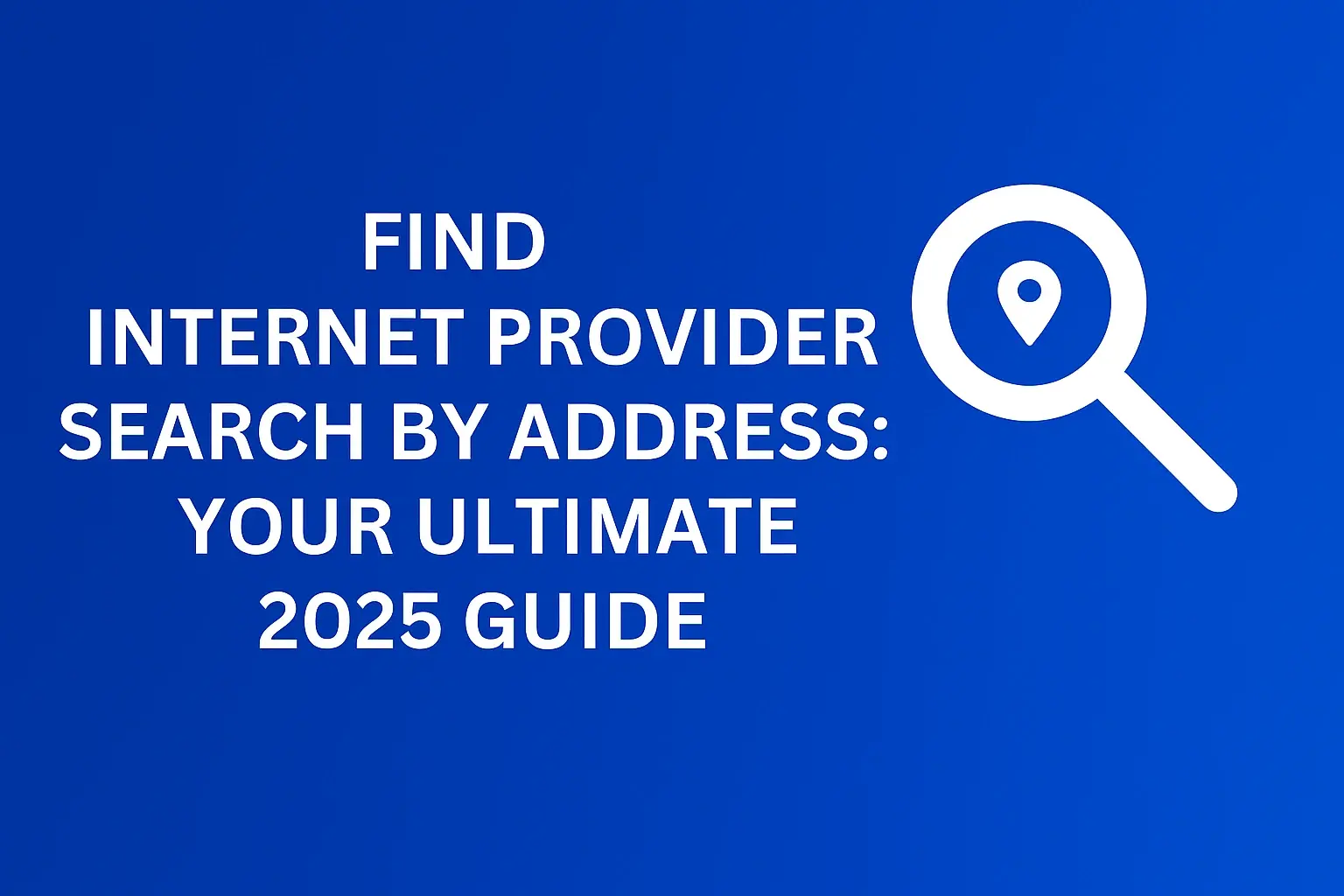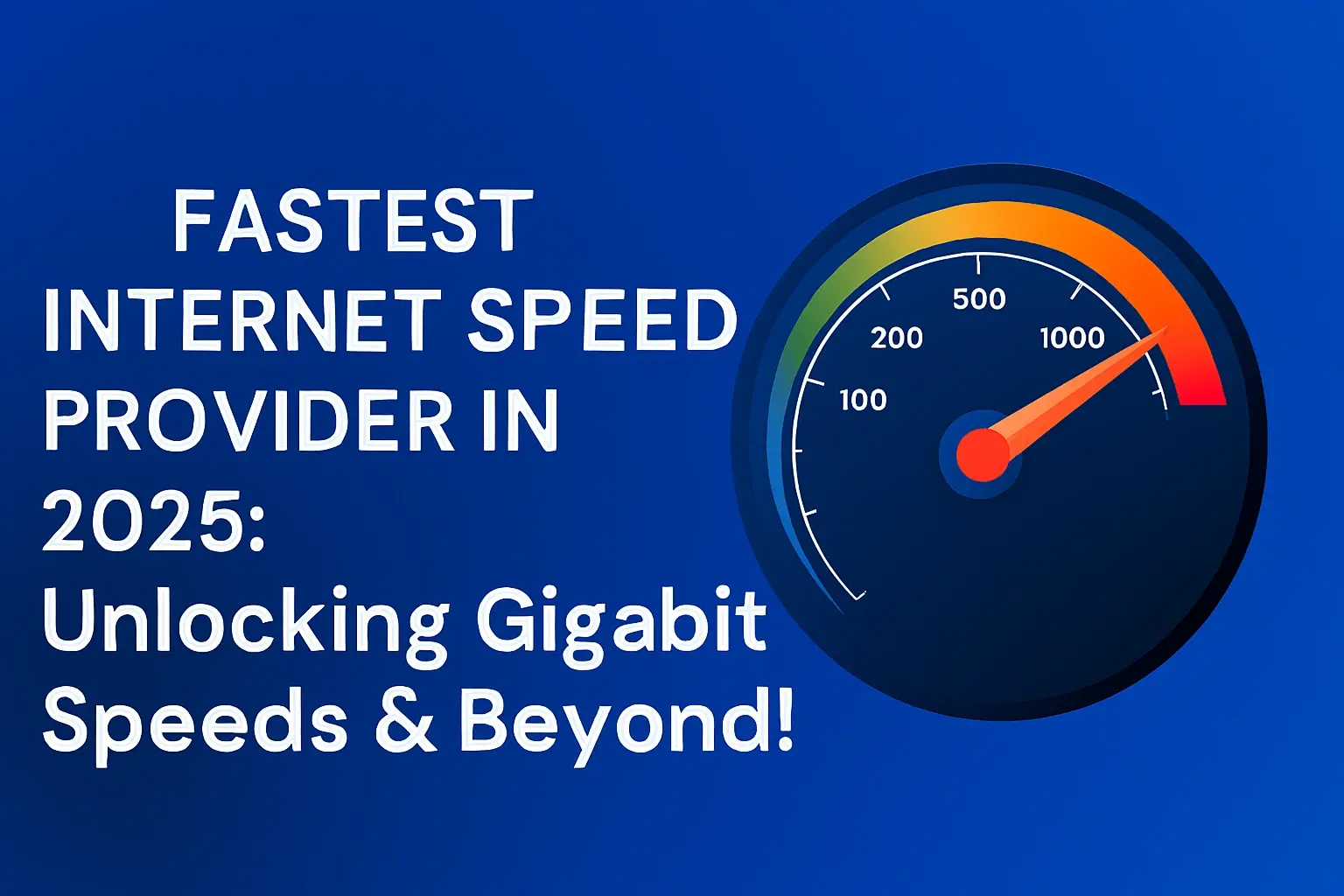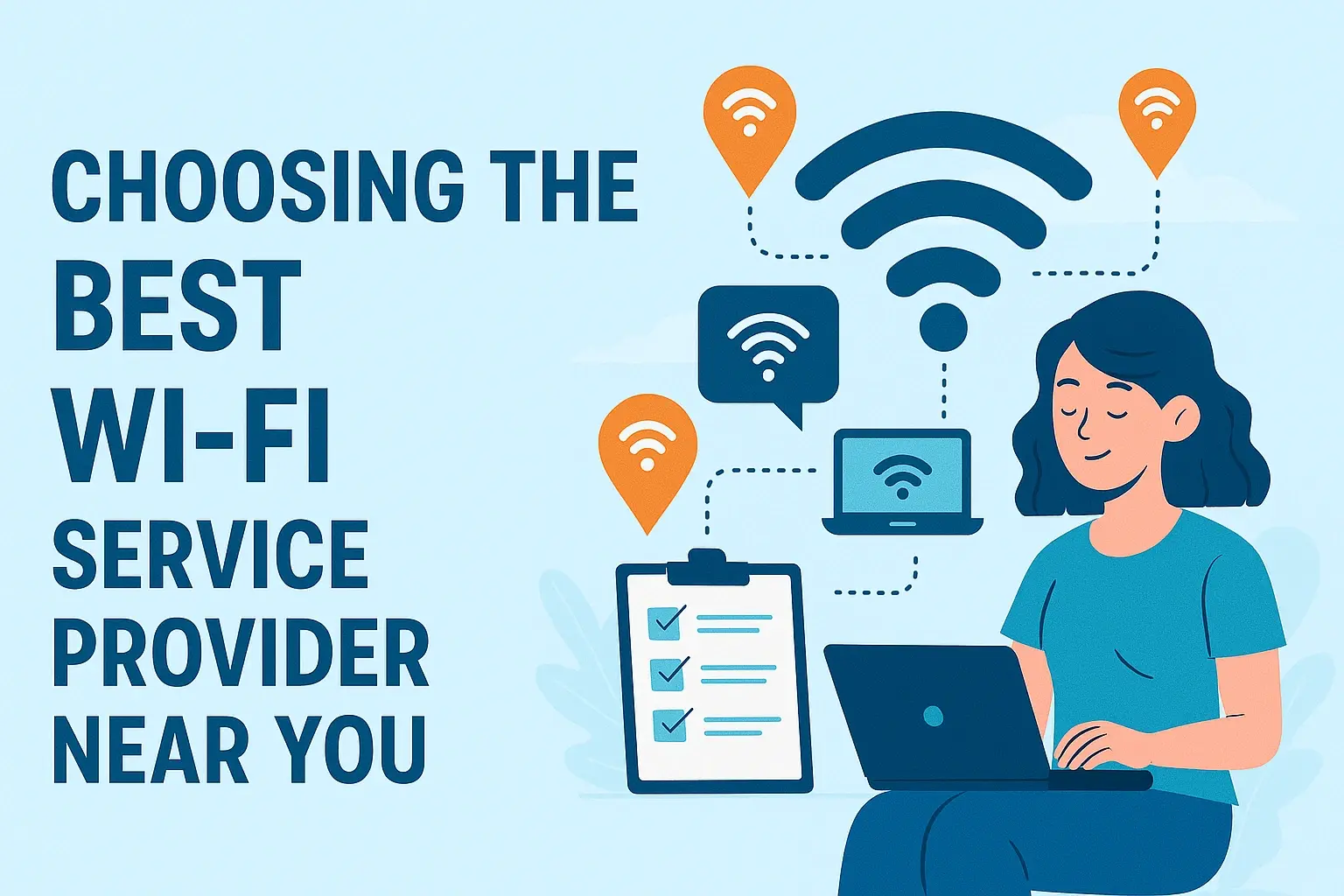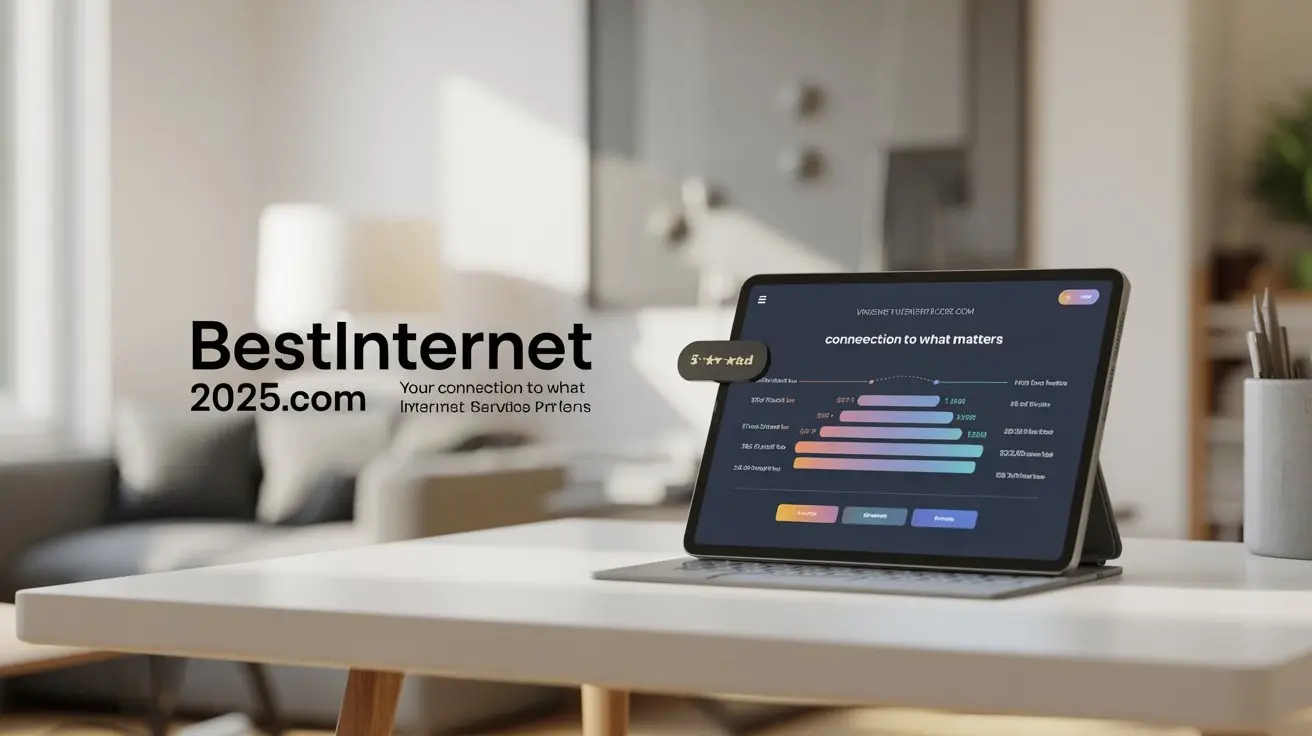How to Find the Best Business Internet Service Provider (ISP) for Your Company
-for-Your-Company.webp)
Finding the right business internet service provider (ISP) is crucial for seamless operations, productivity, and growth. This guide will equip you with the knowledge to navigate the complexities and secure the best ISP for your company's unique needs, ensuring you avoid costly mistakes and downtime.
Understanding Your Business Internet Needs
Before you even begin researching ISPs, the most critical step is a thorough assessment of your business's specific internet requirements. This foundational understanding will prevent you from overpaying for services you don't need or, conversely, undershooting and facing performance issues. In 2025, businesses of all sizes rely heavily on robust internet connectivity for everything from daily communication and cloud-based applications to video conferencing and large data transfers.
Assessing Bandwidth Requirements
Bandwidth is the capacity of your internet connection to handle data transfer. The more users and devices you have, and the more data-intensive your operations, the higher your bandwidth needs will be. Consider the following:
- Number of Employees: Each employee typically consumes bandwidth for email, web browsing, and internal applications.
- Types of Applications Used: Video conferencing (e.g., Zoom, Microsoft Teams), cloud storage and collaboration tools (e.g., Google Workspace, Microsoft 365), VoIP phone systems, and large file transfers all demand significant bandwidth.
- Number of Connected Devices: Beyond employee computers, consider servers, printers, security cameras, IoT devices, and guest Wi-Fi networks.
- Peak Usage Times: When are your busiest periods? Your internet service must be able to handle peak loads without degradation.
- Future Growth: Anticipate your business's expansion plans. Will you be hiring more staff or adopting new, bandwidth-hungry technologies in the next 1-3 years?
2025 Statistics: According to recent industry reports, the average business now requires at least 100 Mbps download and 50 Mbps upload speeds, with many high-demand sectors like tech and media needing 500 Mbps or more. For businesses heavily reliant on real-time collaboration and large data sets, symmetrical speeds (equal download and upload) are becoming the standard, often exceeding 1 Gbps.
Defining Reliability and Uptime Needs
Downtime can be incredibly costly for any business. For some, even a few minutes of outage can lead to lost revenue, damaged reputation, and decreased employee productivity. Therefore, understanding your business's tolerance for downtime is paramount.
- Cost of Downtime: Quantify what an hour or a day of lost internet access would cost your business in terms of lost sales, missed deadlines, and operational paralysis.
- Critical Business Functions: Identify which business processes are entirely dependent on internet connectivity.
- Service Level Agreements (SLAs): Look for ISPs that offer strong SLAs guaranteeing a certain percentage of uptime (e.g., 99.9% or 99.99%). Understand what constitutes an outage and how credits are issued for breaches.
Considering Security Requirements
In today's digital landscape, cybersecurity is non-negotiable. While your ISP's primary role is connectivity, some providers offer additional security features or can integrate with your existing security infrastructure.
- Managed Security Services: Does the ISP offer firewalls, intrusion detection, or other managed security solutions?
- Network Segmentation: Can the ISP help you set up segmented networks for different departments or guest access to enhance security?
- Data Protection: While not directly an ISP function, understand how your data is transmitted and if the ISP has robust network security protocols in place.
Exploring Different Types of Business Internet Services
The type of internet technology you choose will significantly impact performance, reliability, and cost. Each has its advantages and disadvantages, making it essential to match the technology to your business needs and geographical location.
Fiber Optic Internet
Fiber optic internet uses light signals transmitted through glass or plastic threads to deliver data. It is widely considered the gold standard for business internet due to its superior speed, reliability, and low latency.
- Pros:
- Extremely high speeds (often 1 Gbps and beyond, symmetrical upload/download).
- Highly reliable and less susceptible to interference from weather or electrical signals.
- Low latency, crucial for real-time applications like video conferencing and online gaming.
- Scalable to meet future bandwidth demands.
- Cons:
- Availability is limited, primarily in urban and suburban areas.
- Installation can be more complex and costly.
- May require new wiring within the premises.
Cable Internet
Cable internet uses the same coaxial cable network that delivers cable television. It offers a good balance of speed and affordability for many businesses.
- Pros:
- Widely available in most developed areas.
- Offers competitive speeds, often in the hundreds of Mbps.
- Generally more affordable than fiber.
- Relatively easy installation.
- Cons:
- Speeds can be asymmetrical (download faster than upload).
- Performance can degrade during peak usage hours as bandwidth is shared with other users in the neighborhood.
- More susceptible to signal degradation than fiber.
DSL (Digital Subscriber Line)
DSL internet uses existing telephone lines to transmit data. It's an older technology but can still be a viable option for businesses with lower bandwidth needs or in areas where other options are unavailable.
- Pros:
- Available anywhere with a phone line.
- Can offer "always-on" connectivity.
- Typically more affordable than cable or fiber.
- Cons:
- Significantly slower speeds compared to cable and fiber, especially over longer distances from the telephone exchange.
- Upload speeds are usually very limited.
- Susceptible to interference and line quality issues.
Fixed Wireless Internet
Fixed wireless internet uses radio waves to connect a business to a nearby tower. It's a good option for businesses in rural or hard-to-reach areas where wired infrastructure is lacking.
- Pros:
- Can be deployed quickly in areas without wired infrastructure.
- Can offer competitive speeds, sometimes rivaling cable.
- Less susceptible to physical cable damage.
- Cons:
- Performance can be affected by weather conditions (heavy rain, snow).
- Line-of-sight to the tower is often required, limiting placement options.
- Speeds and reliability can vary significantly between providers and locations.
5G/Mobile Broadband
With the advancement of 5G technology, mobile broadband is becoming a more robust option for businesses, especially for backup connectivity or for businesses with mobile workforces.
- Pros:
- Highly mobile and flexible.
- Can offer impressive speeds, especially in areas with strong 5G coverage.
- Quick to deploy.
- Cons:
- Data caps can be a significant issue for business use.
- Consistency and reliability can be a concern compared to wired options.
- Latency can still be higher than fiber.
- Coverage can be inconsistent, especially indoors or in fringe areas.
Key Factors When Choosing a Business ISP
Beyond the technology type, several other critical factors should influence your decision when selecting a business internet service provider. These elements directly impact your operational efficiency, budget, and overall satisfaction with the service.
Speed and Performance
This is often the most obvious factor, but it's crucial to understand the nuances. Don't just look at advertised download speeds. Consider:
- Download Speed: Essential for receiving data, browsing the web, and streaming content.
- Upload Speed: Increasingly important for sending large files, video conferencing, cloud backups, and VoIP calls. For many businesses, symmetrical speeds (equal download and upload) are highly desirable.
- Latency: The delay between sending a request and receiving a response. Low latency is critical for real-time applications.
- Jitter: Variation in latency. High jitter can cause choppy audio and video in calls.
2025 Trend: The demand for symmetrical gigabit speeds is rising, especially for businesses leveraging cloud-native applications and extensive remote collaboration. Many ISPs are now offering tiered business plans that go beyond 1 Gbps.
Reliability and Uptime Guarantees (SLAs)
As discussed earlier, downtime is expensive. A strong Service Level Agreement (SLA) is non-negotiable for critical business operations.
- Uptime Percentage: Aim for 99.9% or higher. A 99.9% uptime means approximately 8.76 hours of downtime per year, while 99.99% allows for only 52.56 minutes.
- Guaranteed Performance Metrics: Does the SLA cover not just uptime but also latency and packet loss?
- Remedies for Breaches: What compensation or credits do you receive if the ISP fails to meet its SLA?
- Proactive Monitoring: Does the ISP actively monitor its network to prevent outages?
Customer Service and Technical Support
When issues arise, prompt and effective support is vital. Poor customer service can exacerbate problems and lead to prolonged downtime.
- Availability: Is support available 24/7?
- Responsiveness: How quickly do they respond to inquiries and service requests?
- Expertise: Are the support technicians knowledgeable and capable of resolving complex business-related issues?
- Dedicated Business Support: Some ISPs offer dedicated account managers or business support teams, which can be invaluable.
Contract Terms and Pricing
Understand the full cost and commitment involved. Be wary of hidden fees and long-term contracts that might not suit your evolving business needs.
- Contract Length: Are you locked into a 1, 2, or 3-year contract? Are there early termination fees?
- Installation Fees: Are there upfront costs for setting up the service?
- Equipment Rental Fees: Do you need to rent modems or routers, or can you use your own?
- Hidden Fees: Look out for fees related to data overages (if applicable), service changes, or maintenance.
- Price Increases: Are there provisions for price increases after an introductory period?
Scalability
Your business will likely grow and evolve. Your internet service should be able to keep pace without requiring a complete overhaul.
- Upgrade Options: How easy and costly is it to upgrade your speed or bandwidth as your needs increase?
- Technology Roadmap: Does the ISP invest in upgrading its infrastructure to offer newer, faster technologies in the future?
Security Features
While not always a primary function of an ISP, some offer bundled security services that can be beneficial.
- Managed Firewalls: Protection against unauthorized access.
- DDoS Protection: Safeguarding against Distributed Denial of Service attacks.
- Content Filtering: Useful for enforcing acceptable use policies.
Bundling Options
Some ISPs offer bundles that include internet, phone (VoIP), and sometimes even TV services. While convenient, ensure the bundled services meet your needs and that the overall cost is competitive.
Comparing Providers and Plans: A Step-by-Step Approach
With your needs defined and understanding of available technologies and key factors, it's time to systematically compare ISPs and their offerings. This structured approach ensures you make an informed decision.
Step 1: Identify Potential Providers in Your Area
Not all ISPs serve every location. Start by identifying which providers offer service at your business address.
- Online Availability Checkers: Most major ISPs have tools on their websites to check serviceability.
- Local Business Organizations: Chambers of Commerce or local business development groups might have insights into available providers.
- Ask Other Local Businesses: Get recommendations from peers in your industry or neighboring businesses.
Step 2: Gather Information on Available Plans
Once you have a list of potential providers, gather detailed information on their business-specific plans.
- Visit Provider Websites: Look for dedicated "Business" sections.
- Request Sales Consultations: Speak directly with sales representatives to get personalized quotes and understand plan details. Be sure to ask specific questions about the factors mentioned in the previous section.
- Read Reviews: Look for reviews from other businesses, focusing on reliability, customer service, and actual performance.
Step 3: Create a Comparison Matrix
A table is an excellent tool for organizing and comparing the features of different plans. This will help you visualize the pros and cons side-by-side.
| Feature | Provider A (e.g., Fiber) | Provider B (e.g., Cable) | Provider C (e.g., Fixed Wireless) |
|---|---|---|---|
| Technology Type | Fiber Optic | Cable | Fixed Wireless |
| Advertised Download Speed | 1 Gbps | 500 Mbps | 300 Mbps |
| Advertised Upload Speed | 1 Gbps (Symmetrical) | 50 Mbps | 50 Mbps |
| Monthly Price (Introductory) | $150 | $100 | $90 |
| Contract Length | 2 Years | 1 Year | 1 Year |
| SLA Uptime Guarantee | 99.99% | 99.9% | 99.5% |
| Installation Fee | $200 (Waived with 3-yr contract) | $100 | $50 |
| Customer Support Rating (from reviews) | Excellent | Good | Fair |
| Additional Business Features | Static IP, Priority Support | Basic Support | N/A |
Step 4: Evaluate Total Cost of Ownership
Look beyond the monthly price. Calculate the total cost over the contract period, including installation, equipment, and any potential price increases.
Example Calculation (for 2 years):
- Provider A: ($150/month * 24 months) + $200 installation = $3,800
- Provider B: ($100/month * 24 months) + $100 installation = $2,500
- Provider C: ($90/month * 24 months) + $50 installation = $2,210
This example highlights that the cheapest upfront option isn't always the best value when considering performance and reliability.
Step 5: Read the Fine Print
Before signing, meticulously review the contract. Pay close attention to:
- Service Level Agreements (SLAs): Ensure they are clearly defined and understood.
- Early Termination Clauses: Understand the penalties for breaking the contract.
- Data Caps: If applicable, understand the limits and overage charges.
- Price Escalation: Note any planned price increases.
Step 6: Conduct a Trial Period (If Possible)
Some ISPs offer trial periods. If available, take advantage of this to test the service in real-world conditions before committing long-term.
Negotiating and Signing the Contract
Once you've narrowed down your choices, don't be afraid to negotiate. ISPs are often willing to offer better terms to secure business clients, especially for longer contracts or higher-tier services.
Negotiation Tactics
- Leverage Competition: Mention quotes or offers from competing providers.
- Ask for Discounts: Inquire about introductory offers, long-term customer discounts, or bundled service savings.
- Negotiate Fees: Try to get installation fees waived or reduced, or negotiate better equipment rental terms.
- Seek Longer Contract Terms for Better Rates: If you're confident in your choice, a longer commitment might yield a lower monthly rate.
- Clarify SLAs: Ensure the SLA meets your business's needs and ask for specific performance guarantees.
- Request a Dedicated Account Manager: This can significantly improve your support experience.
Understanding Contract Clauses
As mentioned, the contract is critical. Here are key clauses to scrutinize:
- Term of Service: The duration of the contract.
- Termination Clause: Conditions under which either party can end the agreement and associated fees.
- Service Level Agreement (SLA): The guarantees regarding uptime, performance, and remedies.
- Force Majeure: Clauses that excuse performance due to events beyond control (e.g., natural disasters).
- Limitation of Liability: Caps on the ISP's financial responsibility for service disruptions or damages.
- Equipment Provisions: Details on who owns the equipment and responsibilities for maintenance and replacement.
- Change of Service: How changes to your service plan are handled.
Signing the Contract
Once you've negotiated favorable terms and are satisfied with the contract, proceed with signing. Ensure all agreed-upon terms are accurately reflected in the final document. Keep a signed copy for your records.
Managing Your Business Internet Service Post-Installation
Securing the right ISP is only half the battle. Ongoing management and optimization are crucial for ensuring your business continues to receive the best possible service and value.
Monitoring Performance
Don't assume everything will run perfectly forever. Regularly monitor your internet performance.
- Speed Tests: Conduct regular speed tests (e.g., using Ookla Speedtest or similar tools) during peak and off-peak hours to verify you're receiving the speeds you're paying for.
- Network Monitoring Tools: For more advanced needs, consider implementing network monitoring software that can track bandwidth usage, latency, and uptime.
- Track Downtime: Keep a log of any service interruptions, including the date, time, duration, and the impact on your business. This is vital if you need to claim SLA credits.
Optimizing Your Network
Even with a great ISP, your internal network setup can impact performance.
- Router and Firewall Configuration: Ensure your network equipment is properly configured and up-to-date.
- Wi-Fi Optimization: For wireless networks, ensure good coverage, minimize interference, and use strong security protocols (e.g., WPA3).
- Quality of Service (QoS): If your router supports it, configure QoS to prioritize critical applications like VoIP or video conferencing over less time-sensitive traffic.
- Bandwidth Management: Understand which applications or devices are consuming the most bandwidth and consider implementing policies or upgrades if necessary.
Staying Informed About New Technologies and Offers
The telecommunications landscape is constantly evolving.
- ISP Updates: Keep an eye on your ISP's communications regarding network upgrades or new service offerings.
- Market Research: Periodically review the market to see if better or more cost-effective options have become available, especially as your contract nears its end.
- Industry Trends: Stay aware of emerging technologies that could benefit your business, such as advancements in Wi-Fi, 5G, or SD-WAN.
Leveraging Your SLA
If your ISP fails to meet its SLA guarantees, don't hesitate to use it.
- Document Everything: Keep detailed records of all outages and performance issues.
- Contact Support Promptly: Report issues as soon as they occur.
- Formal Claims: Follow your ISP's procedure for claiming SLA credits. Be persistent but professional.
Planning for Disaster Recovery and Redundancy
For businesses where internet connectivity is absolutely critical, consider a secondary internet connection.
- Backup ISP: A secondary connection from a different provider using a different technology (e.g., fiber primary, fixed wireless backup) can ensure continuity during an outage.
- Failover Systems: Implement automatic failover systems that switch traffic to the backup connection seamlessly when the primary fails.
- Mobile Hotspots: For very small businesses or temporary needs, mobile hotspots can serve as a basic backup.
2025 Insight: SD-WAN (Software-Defined Wide Area Network) solutions are becoming increasingly popular for managing multiple internet connections, optimizing traffic, and improving resilience. They offer advanced control and visibility over your network infrastructure.
Choosing the best business internet service provider is a strategic decision that requires careful planning, thorough research, and ongoing management. By understanding your business's unique needs, exploring available technologies, and diligently comparing providers, you can secure a robust, reliable, and cost-effective internet solution. Always prioritize strong SLAs, responsive customer support, and scalable options that can grow with your company. Don't hesitate to negotiate terms and regularly monitor your service to ensure optimal performance. Investing the time upfront will pay dividends in sustained productivity, reduced operational risks, and ultimately, business success.





